Did you know that 91% of all pages receive zero organic traffic from Google? Even one broken link, one duplicate title, or one keyword-stuffed description can tank your rankings before you realize it. BigCommerce SEO mistakes happen more frequently than you might think. Despite being one of the most prevalent e-commerce solutions on the internet today, founded in 2009, many store owners struggle with its unique SEO challenges. From limited URL customization to subpar site structure options, these issues can seriously hinder your online visibility.
However, there’s good news. With effective BigCommerce SEO, your store can rise to the top positions that customers find when searching for products on Google. This is where partnering with a specialized BigCommerce SEO agency becomes valuable. As search positions improve, the number of products displayed generally increases, directly affecting your bottom line.
Hence, in this comprehensive guide, we’ll identify the most common BigCommerce SEO mistakes and provide actionable fixes to boost your rankings, increase organic traffic, and drive more sales in 2025.
How to Fix Common BigCommerce SEO Mistakes in 2025
Why Fixing SEO Issues Should Be a Priority
9 Common Bigcommerce SEO Mistakes To Avoid
1. Duplicate Product Descriptions
4. Missing or Poorly Optimized Meta Tags
5. Thin Content on Category Pages
6. Lack of Mobile Optimization
7. Ignoring Structured Data (Schema)
8. No Internal Linking Strategy
Advanced SEO Fixes for BigCommerce in 2025
Why Choose Rankfast as Your BigCommerce SEO Agency
Why Fixing SEO Issues Should Be a Priority
Set up the promise: By the end, you’ll know how to prevent and fix these issues.
- Organic search drives over 53% of eCommerce traffic (BrightEdge).
- 75% of searchers never click past the first page (HubSpot).
- SEO mistakes lead to loss of visibility, credibility, and sales.
- Reference the competitive landscape in your target countries.
The numbers tell a compelling story about why addressing BigCommerce SEO mistakes should top your priority list. These statistics highlight why proper SEO implementation isn’t optional but essential for your online store’s success.
Each unresolved SEO issue directly impacts your bottom line. Specifically, poor optimization leads to:
- Dramatically reduced visibility in search results
- Lower credibility with both search engines and customers
- Significant loss of potential sales and revenue
This reality becomes even more critical when examining the competitive landscape across markets like India, UAE, and the US. In India, the e-commerce sector is growing at 27% annually, creating fierce competition for visibility. UAE’s digital marketplace is similarly expanding, with 92% of its population shopping online. Meanwhile, the mature US market demands exceptional SEO execution to stand out among established competitors.
Throughout the remainder of this guide, you’ll discover actionable solutions to each common BigCommerce SEO mistake. By implementing these fixes, you’ll not only prevent SEO pitfalls but also position your store for maximum visibility and growth in 2025’s increasingly competitive digital landscape.
9 Common Bigcommerce SEO Mistakes To Avoid
Common BigCommerce SEO mistakes can significantly affect your store’s performance and revenue. Let’s explore ten major issues and practical solutions to boost your online visibility.
- Duplicate Product Descriptions
One of the most frequent BigCommerce SEO mistakes occurs when store owners copy manufacturer descriptions or use identical content across similar products. This practice creates duplicate content—a critical issue that confuses search engines about which version to index and rank.
Ref: Link
Search engines like Google aim to provide diverse, valuable results to users. When they encounter multiple pages with the same content, they must decide which version is most relevant—often resulting in lower rankings for all duplicated pages. Additionally, search engines may reduce the crawl budget allocated to your site if they discover excessive duplicate content.
To fix this issue:
- Create unique product descriptions for each item in your inventory. Focus on specific features, benefits, and use cases that make each product distinct.
- Incorporate relevant keywords naturally throughout the description, particularly in the first 100 words. Research shows that product pages with unique, keyword-rich descriptions rank 58% better than those with duplicate content.
- Utilize BigCommerce’s custom fields to differentiate similar products. These fields allow you to add unique attributes without modifying the core description.
- Implement regular content audits using tools like Copyscape or Siteliner to identify duplicate content across your store.
A real-world example demonstrates the effectiveness of this approach. An Indian clothing retailer struggled with poor rankings despite offering high-quality products. After identifying duplicate content as the culprit, they rewrote over 500 product descriptions with unique, culturally relevant content that addressed specific customer needs in the Indian market. Within three months, their organic traffic increased by 43%, and their conversion rate improved by 2.8%.
2. Poor URL Structure
The URLs of your BigCommerce store play a crucial role in both user experience and search engine optimization. Unfortunately, many store owners overlook this aspect, settling for auto-generated URLs that contain random numbers, special characters, or unnecessary parameters.
Poorly structured URLs negatively impact:
- Click-through rates: Users are less likely to click on confusing URLs in search results
- Keyword targeting: Missing an opportunity to include relevant keywords
- Indexing efficiency: Making it harder for search engines to understand page content
- User experience: Creating difficulty in sharing or remembering URLs
To optimize your BigCommerce URLs:
- Keep URLs short and descriptive, ideally under 60 characters. For instance, use /mens-running-shoes instead of /product?id=12345&category=footwear&type=running.
- Include primary keywords near the beginning of the URL. This helps search engines understand the page content.
- Use hyphens to separate words rather than underscores or spaces, as recommended by Google.
- Implement 301 redirects when changing existing URLs to prevent broken links and preserve SEO value. BigCommerce offers built-in tools for creating these redirects.
- Maintain a logical hierarchy in your URL structure (e.g., /category/subcategory/product-name).
3. Slow Page Load Speeds
In 2025, page speed remains a critical ranking factor. According to research, a mere 1-second delay in page load time can reduce conversions by 7%. Additionally, 40% of visitors abandon websites that take more than 3 seconds to load.
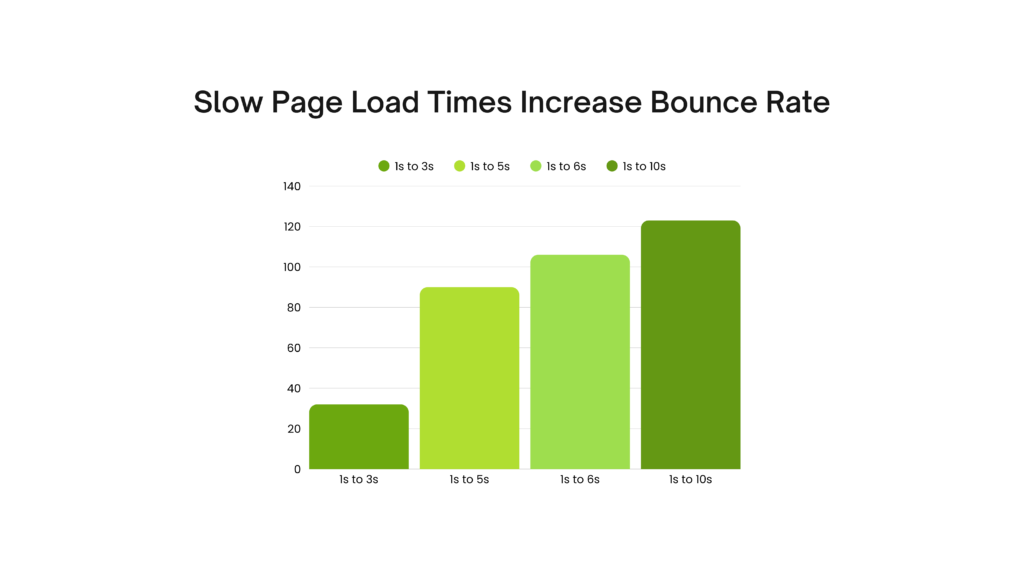
Common causes of slow-loading BigCommerce stores include:
- Unoptimized images
- Excessive third-party scripts
- Lack of browser caching
- No Content Delivery Network (CDN) implementation
- Bloated themes with unnecessary code
To improve your BigCommerce store’s loading speed:
- Compress all images using tools like TinyPNG or ImageOptim before uploading. This can reduce file sizes by up to 70% without noticeable quality loss.
- Enable BigCommerce’s built-in Akamai Image Manager, which automatically optimizes images and serves them from a global CDN.
- Minify CSS and JavaScript files to remove unnecessary characters and whitespace, reducing file sizes.
- Limit third-party apps and scripts to only those essential for your store’s functionality.
- Use Google PageSpeed Insights and GTmetrix to identify specific speed issues and track improvements.
4. Missing or Poorly Optimized Meta Tags
Meta tags remain fundamental SEO elements, yet many BigCommerce store owners either neglect them entirely or implement them incorrectly. The two most critical meta tags are the title tag and meta description.
Problems with meta tags typically include:
- Missing tags altogether
- Using the same meta title and description across multiple pages
- Exceeding recommended character limits
- Failing to include relevant keywords
- Generic content that doesn’t encourage clicks
For effective meta tag optimization:
- Create unique meta titles for each page, keeping them under 60 characters. Include your primary keyword near the beginning, followed by your brand name.
- Craft compelling meta descriptions under 160 characters that include a value proposition and call-to-action. These won’t directly impact rankings but can significantly improve click-through rates.
- Include relevant keywords naturally without keyword stuffing.
- Add schema markup to enhance your search listings with additional information like ratings, prices, and availability.
An Indian furniture store implemented this approach and saw remarkable results. By optimizing meta tags across their product catalog with location-specific keywords and clear value propositions, they doubled their click-through rate from search results in just two months.
5. Thin Content on Category Pages
Category pages often serve as landing pages for valuable commercial keywords, yet many BigCommerce stores leave these pages with minimal content—typically just a product grid without contextual information.
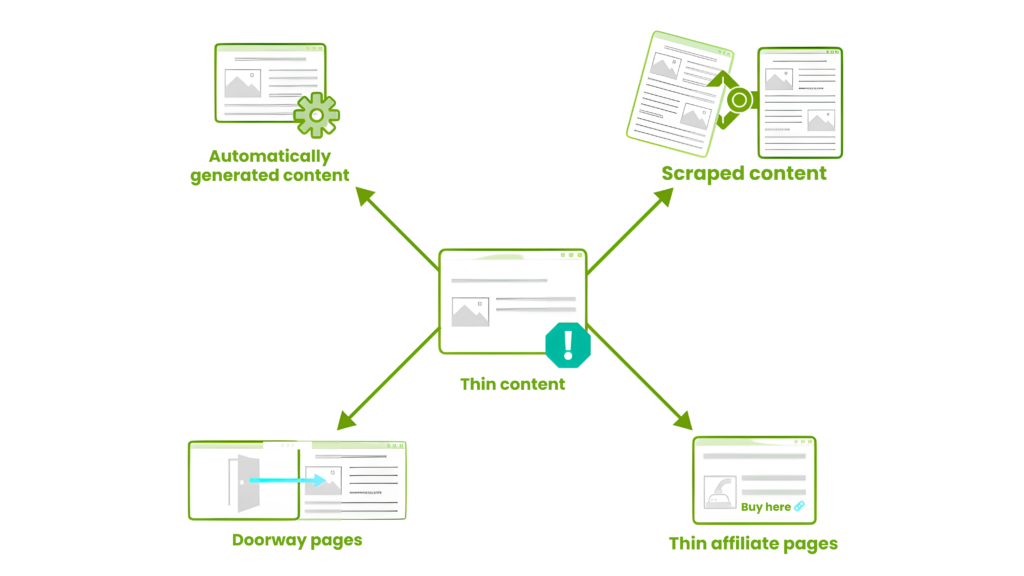
Search engines value comprehensive content that demonstrates expertise and relevance. Category pages with thin content struggle to rank for competitive terms regardless of how well-optimized other elements may be.
To enhance your category pages:
- Add 200-300 words of relevant, informative content at the top or bottom of category pages. This text should describe the product category, highlight key features, and address common customer questions.
- Include category-specific FAQs that address common customer queries. This provides additional content value while helping shoppers make informed decisions.
- Implement internal linking within category descriptions to connect related categories and important product pages.
- Use headers (H1, H2, H3) to structure your category content logically, incorporating relevant keywords naturally.
- Update category content seasonally to reflect changing trends, sales, or new product additions.
Mobile searches now account for over half of all web traffic worldwide. Yet many BigCommerce store owners continue to neglect this critical aspect of their online presence. Let’s examine the remaining critical SEO issues affecting many online stores in 2025.
6. Lack of Mobile Optimization
The statistics speak volumes: 60% of all online searches come from mobile devices, with mobile commerce expected to represent 72.9% of total e-commerce sales by 2025. Nevertheless, numerous BigCommerce stores remain poorly optimized for mobile users.
Common mobile optimization issues include:
- Slow-loading mobile pages (taking more than 3 seconds)
- Difficult navigation on smaller screens
- Text too small to read without zooming
- Clickable elements are placed too close together
- Images are not properly sized for mobile viewing
To fix these mobile optimization issues:
- Use responsive BigCommerce themes that automatically adjust to various screen sizes. Stencil themes are particularly effective for mobile responsiveness.
- Test your store regularly using Google’s Mobile-Friendly Test tool to identify specific mobile usability issues.
- Implement mobile-specific navigation that simplifies the user journey on smaller screens. Consider hamburger menus, simplified search functions, and prominent call-to-action buttons.
- Ensure touch elements are appropriately sized and spaced (at least 44×44 pixels) to prevent accidental clicks.
7. Ignoring Structured Data (Schema)
Structured data helps search engines understand your content better, yet many BigCommerce stores overlook this powerful SEO element. Without proper schema markup, you miss opportunities for enhanced search results through rich snippets.
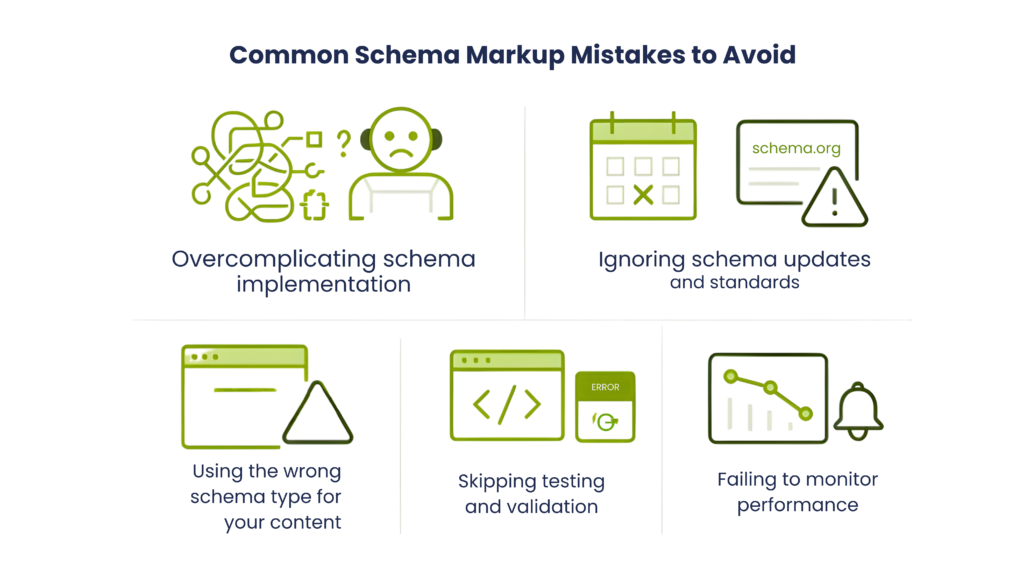
Essential schema types for BigCommerce stores include:
- Product schema – Displays price, availability, and ratings directly in search results
- Review schema – Shows star ratings to increase click-through rates
- Breadcrumb schema – Improves navigation understanding for search engines
- Organization schema – Provides company information for knowledge panels
To implement structured data effectively:
- Add Product schema to all product pages using BigCommerce’s built-in functionality or third-party apps like Schema App.
- Implement Review schema to showcase customer feedback directly in search results.
- Test your implementation using Google’s Rich Results Test to ensure proper formatting and identify any errors.
8. No Internal Linking Strategy
A strategic approach to internal linking helps distribute page authority throughout your store and guides users to related products. Without it, valuable pages may remain undiscovered by both search engines and shoppers.
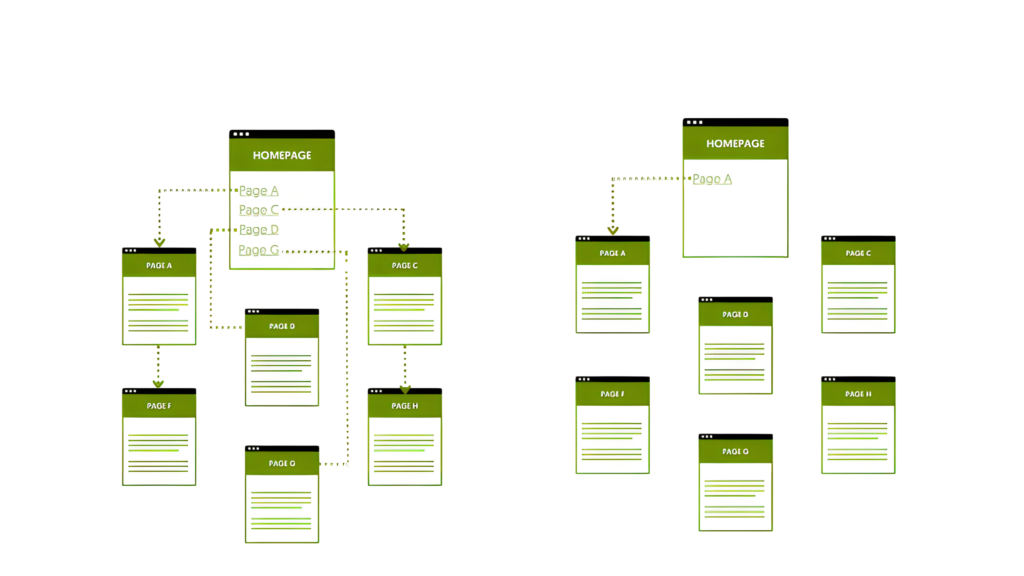
To develop an effective internal linking strategy:
- Link contextually between related products and categories using descriptive anchor text with relevant keywords.
- Create “Related Products” sections that automatically suggest complementary items based on browsing history or purchase patterns.
- Implement breadcrumb navigation to help users understand their location within your site hierarchy.
- Link from high-authority pages (like your homepage or popular blog posts) to important product categories to pass link equity.
Working with a specialized bigcommerce seo agency can help identify opportunities for strategic internal linking that might otherwise be missed.
9. Weak Local SEO Setup
For BigCommerce stores serving specific geographic areas, local SEO presents unique opportunities. Yet many fail to implement proper local optimization, missing valuable nearby customers.
To strengthen your local SEO presence:
- Create location-specific landing pages with unique content tailored to each market you serve.
- Incorporate local keywords in product titles and descriptions where relevant.
- Claim and optimize your Google Business Profile with accurate business information, photos, and regular posts.
A proper local SEO strategy implemented through quality bigcommerce seo services can dramatically improve visibility in location-based searches, driving both online sales and in-store traffic for businesses with physical locations.
Advanced SEO Fixes for BigCommerce in 2025
As competition grows and search algorithms become smarter, basic SEO is no longer enough. To maximize organic visibility and sales in 2025, you need advanced strategies that address modern search behaviors and technology.
AI-driven Product Recommendations for SEO
Artificial intelligence can analyze shopper behavior to suggest products they’re more likely to buy. When implemented with SEO in mind, these recommendations also create internal links, increase dwell time, and improve topical relevance—sending positive signals to search engines.
Voice Search Optimization for Product Queries
With over 8.4 billion voice assistants projected to be in use globally by 2025 (Statista), optimizing for voice search is essential. Include conversational, long-tail keywords in product descriptions and FAQs so your store appears for spoken queries like “Where can I buy organic bedsheets in Dubai?”
Image SEO with Descriptive Filenames and Alt Text
High-quality visuals attract buyers, but without optimization, they’re invisible to search engines. Use descriptive filenames (e.g., black-leather-handbag-uae.jpg) and keyword-rich alt text to improve rankings in Google Images and boost accessibility.
Video Content on Product Pages
Videos can increase conversions by up to 80% (EyeView Digital). Adding product demos or tutorials not only engages customers but also enhances SEO, as search engines reward multimedia-rich pages.
Multilingual SEO for Cross-Border Sales in the UAE and India
If you target diverse markets, offering content in multiple languages helps capture regional search traffic. Implement hreflang tags, create language-specific URLs, and ensure cultural relevance in product descriptions for better rankings in Hindi, Arabic, and English search queries.
Why Choose Rankfast as Your BigCommerce SEO Agency
Choosing the right BigCommerce SEO company can mean the difference between stagnant traffic and measurable growth. At Rankfast, we specialize in BigCommerce SEO services tailored for competitive markets in India, UAE, and the US.
Our expertise spans technical SEO—fixing site speed, schema, and structure—to content strategies that target high-intent keywords and attract qualified buyers. We’ve helped retailers increase organic sales by over 120% in under 12 months through data-driven campaigns.
What sets us apart is our ability to combine technical precision with creative content, backed by advanced analytics. We don’t just optimize for rankings—we optimize for conversions.
Plus, our SEO campaigns work seamlessly with complementary services like PPC for eCommerce, ensuring your store benefits from both organic and paid growth. When you choose Rankfast, you’re partnering with a team that understands your platform, your market, and your revenue goals.
Conclusion
Fixing BigCommerce SEO mistakes isn’t just about avoiding penalties—it’s about building a foundation for long-term sales growth. In 2025, with more competition and smarter algorithms, ongoing SEO optimization is essential to stay ahead.
From AI-driven recommendations to multilingual SEO, every improvement you make compounds over time, attracting more qualified buyers and increasing your store’s authority. But SEO isn’t a one-time effort—it requires regular monitoring, adjustments, and adoption of new trends.
If you’re ready to eliminate SEO roadblocks and unlock your BigCommerce store’s full potential, partner with a trusted BigCommerce SEO company. At Rankfast, we combine proven strategies, cutting-edge tools, and market expertise to deliver measurable results. Contact us today for a customized SEO audit and strategy designed to drive your store’s growth.
FAQs
Q1. How can I improve my BigCommerce store’s SEO in 2025?
To improve your BigCommerce store’s SEO, focus on creating unique product descriptions, optimizing URL structures, enhancing page load speeds, utilizing meta tags effectively, and ensuring mobile-friendliness. Additionally, implement structured data, develop a strong internal linking strategy, and optimize for local SEO if applicable.
Q2. Why is mobile optimization crucial for BigCommerce stores?
Mobile optimization is essential because over 60% of online searches come from mobile devices, and mobile commerce is expected to represent 72.9% of total e-commerce sales by 2025. A mobile-friendly store ensures better user experience, higher search rankings, and increased conversions from mobile users.
Q3. What are the consequences of having duplicate product descriptions?
Duplicate product descriptions can confuse search engines, leading to lower rankings for all duplicated pages. This can result in reduced visibility in search results, decreased organic traffic, and ultimately, fewer sales for your BigCommerce store.
Q4. How does structured data benefit my BigCommerce store?
Structured data helps search engines better understand your content, enabling rich snippets in search results. This can increase click-through rates, improve visibility, and provide users with more information directly in search results, potentially boosting your store’s performance in search rankings.
Q5. What’s the importance of optimizing category pages on BigCommerce?
Optimizing category pages is crucial because they often serve as landing pages for valuable commercial keywords. By adding relevant, informative content and implementing proper SEO techniques on these pages, you can improve their ranking potential, provide a better user experience, and increase the likelihood of conversions.
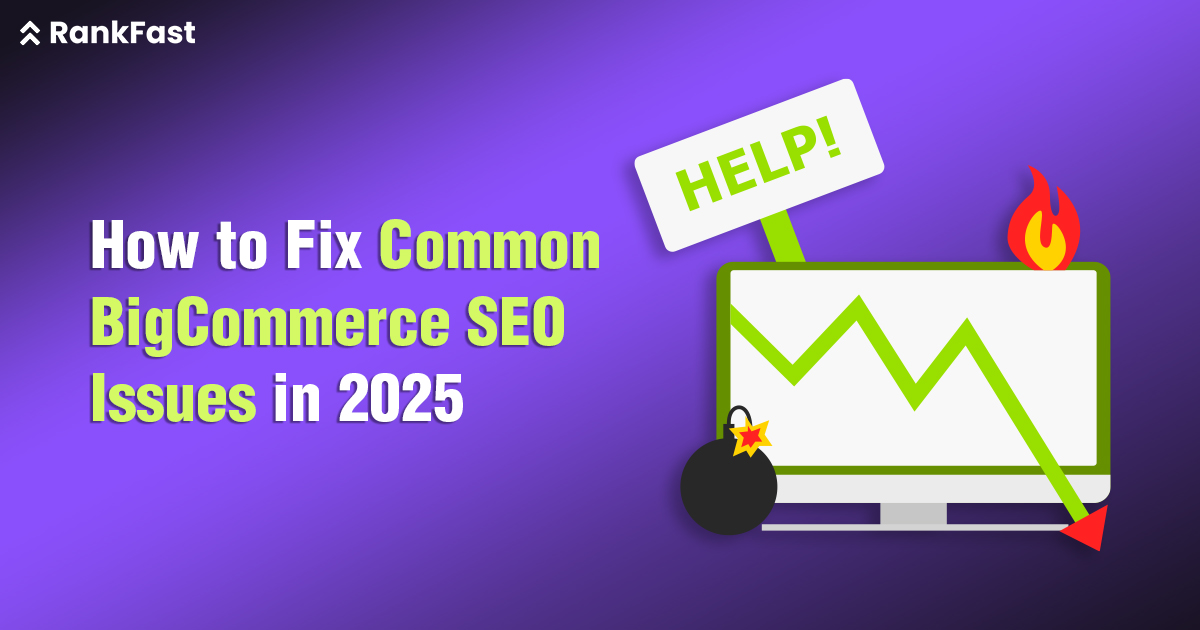
Leave a Reply